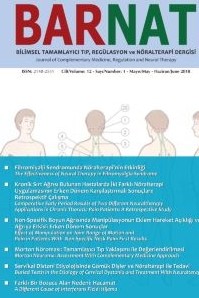ORTOMOLEKÜLER TIP YAKLAŞIMIYLA MAGNEZYUM TAKVİYELERİ
Magnezyum, ortomoleküler tıp, besin takviyesi, tamamlayıcı tıp
MAGNESIUM SUPPLEMENTS BY ORTHO MOLECULAR MEDICINE APPROACH
Magnesium, orthomolecular medicine, food suplements, comlemantary medicine,
___
- Bo S, Pisu E. Role of dietary magnesium in cardiovascular disease prevention, insulin sensitivity and diabetes. Curr Opin Lipidol. 2008 Feb;19(1):50-6.
- Champagne CM. Magnesium in hypertension, cardiovascular disease, metabolic syndrome, and other conditions: a review. Nutr Clin Pract. 2008 Apr-May;23(2):142-51.
- Chiuve SE, Korngold EC, Januzzi JL, Gantzer ML, Albert CM. Plasma and dietary magnesium and risk of sudden cardiac death in women. Am J Clin Nutr. 2011;93(2):253-60.
- Eby GA, Eby KL. Rapid recovery from major depression using magnesium treatment.Med Hypotheses. 2006;67(2):362-70.
- Johnson S. The multifaceted and widespread pathology of magnesium deficiency. Med Hypotheses. 2001;56(2):163-170.
- Moulin DE. Systemic drug treatment for chronic musculoskeletal pain. Clin J Pain. 2001;17(4 Suppl):S86-S93.
- Witkowski M, Hubert J, Mazur A. Methods of assessment of magnesium status in humans: a systematic review. Magnesium Res 2011;24:163-80. [PubMed abstract]
- Lindberg JS, Zobitz MM, Poindexter JR, Pak CY. Magnesium bioavaila- bility from magnesium citrate and magnesium oxide. J Am Coll Nutr 1990;9:48-55. [PubMed abstract]
- Walker AF, Marakis G, Christie S, Byng M. Mg citrate found more bioava- ilable than other Mg preparations in a randomized, double-blind study. Mag Res 2003;16:183-91. [PubMed abstract]
- McKee JA, Brewer RP, Macy GE, et al. Analysis of the brain bioavailabi- lity of peripherally administered magnesium sulfate: A study in humans with acute brain injury undergoing prolonged induced hypermagnese- mia. Crit Care Med. 2005 Mar;33(3):661-6.
- Abumaria N, Yin B, Zhang L, Zhao L, Liu G. Enhancement of cognitive control of emotions by elevated brain magnesium leads to anti-depres- sants like effect. Poster presentation #549. Society for Neuroscience 2009 Meeting. October 20, 2009. Chicago, IL
- Slutsky I, Abumaria N, Wu LJ, et al. Enhancement of learning and me- mory by elevating brain magnesium. Neuron. 2010 Jan 28;65(2):165-77. 9. Barbagallo M, Belvedere M, Dominguez LJ. Magnesium homeostasis and aging. Magnes Res. 2009 Dec;22(4):235-46.
- Durlach, J. Importance and clinical forms of chronic primary magnesium deficiency in human beings. Magnesium Res. 2001; 14: 83–84
- Zhao L, Lou JS, Kang Y. Taurine-magnesium coordination compound at- tenuates hypoxia/reoxygenation induced Ion channel dysfunction in rat ventricular myocytes. Drug Res (Stuttg). 2013 Mar 13.
- Rude RK, Singer FR, Gruber HE. Skeletal and hormonal effects of magne- sium deficiency. J Am Coll Nutr. 2009 Apr;28(2):131-41.
- Hoane MR, Gilbert DR, Barbre AB, Harrison SA. Magnesium dietary ma- nipulation and recovery of function following controlled cortical damage in the rat. Magnes Res. 2008 Mar;21(1):29-37.
- ISSN: 2148-2551
- Başlangıç: 2006
- Yayıncı: Bilimsel Nöralterapi ve Regülasyon Derneği
FONKSİYONEL VE DEJENERATİF BEL ŞİKAYETLERİNDE NÖRALTERAPİ VE MANUEL TIP YAKLAŞIMI
Neslihan ÖZKAN, Hüseyin NAZLIKUL
ORTOMOLEKÜLER TIP YAKLAŞIMIYLA MAGNEZYUM TAKVİYELERİ
ÜLSERATİF KOLİT’Lİ BİR HASTANIN NÖRALTERAPİ VE DİĞER KOMPLEMENTER TEDAVİLER İLE TAKİBİ
FASYA FONKSİYONLARI, İŞLEVSEL GÖREVLERİ VE NÖRALTERAPİ YAKLAŞIMI
Tijen ACARKAN, Hüseyin NAZLIKUL
YARA İYİLEŞMESİNDE BAĞ DOKUSUNUN YERİ VE NÖRALTERAPİ YAKLAŞIMI
